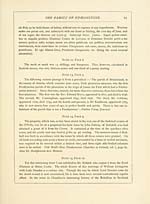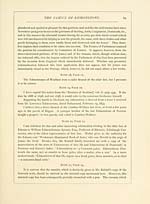Download files
Complete book:
Individual page:
Thumbnail gallery: Grid view | List view

68 NOTES TO GENEALOGICAL ACCOUNT OF
is the following : — ' A Lowland cavalier story which has never been hitherto noticed in
print ascribes the fate of the hero to a passion which William, third Viscount of Kilsyth,
not then come to the Peerage, entertained for his lady.' It seems by this story that he
was suspected of having himself fired the fatal shot, and it goes on to state that Dundee's
mother was so convinced of this, that on the new year's morning which succeeded, she
sent Livingston a white night-cap, a pair of white gloves, and a rope, as indicative of her
opinion. It is said, moreover, that she imprecated a curse upon the marriage of the
guilty pair, 'praying to God that should He see fit to permit the unworthy couple to go
out of the world without some visible token of His indignation, He would be pleased to
make her some especial revelation to prevent her from utterly disbelieving His providence
and justice.' On the day of their marriage, moreover, Livingston presented his bride with
a ring, which she lost immediately, and which was considered a bad omen. A century
after, the ring was found in a field near Colzium, with the inscription 'Yours till deathe,'
which was given to my grandfather. My father likewise became possessed of another larger
ring, with a similar inscription, ' Yours only and ever,' which Lady Dundee probably had
given to her husband. The tragic termination gives a peculiar interest to this curious
history.
Note 16, Page ii.
The forfeited estate of Kilsyth was, with others, disposed of by the Barons of the
Scottish Exchequer to ' the Company of Undertakers for raising the Thames water in
York Buildings, London,' in the year 1731. The Company became bankrupt, and the
property passed into the hands of Mr. Campbell of Shawfield, who appears only to have
held it a very short time, and then sold it to Sir Archibald Edmonstone in 1783. The
sum paid for East and West Baronies of Kilsyth, including the lands of Bancloich, in the
parish of Campsie, was about ,£41,000.
Note 17, Page ii.
Among the Kilsyth Records are some of historical interest relating to the time of the
Interregnum. Of those more immediately connected with the locality, is a supplication by
the parishioners of Moniabrugh, and of the Laird of Kilsyth's tenants, to General Monk,
to be relieved from quartering of troops and other services, dated 1658. There are like-
wise petitions of Sir James Livingston of Kilsyth to the King's Commissioner for losses
incurred by quarterings, and plunderings, and burning of his house, also of his tenants,
the substance of which latter petition is the same as that preferred to the Scots Parlia-
ment while Charles the Second was exercising the regal functions in Scotland. In the
Acts of the year 165 1 there is a ' Supplication to the King's most excellent Majesty' on the
part of the tenants of Kilsyth and Bantoun, purporting ' that the enemy on his march from
Edinburgh to Glasgow, two several times in October and February last, came to the afore-
said lands, and there quartered with his whole army for the space of . Likeas
the enemy having placed a garrison in the house of Kilsyth, the said garrison was for the
space of nine weeks entertained by the tenants of the said lands, who beside were
is the following : — ' A Lowland cavalier story which has never been hitherto noticed in
print ascribes the fate of the hero to a passion which William, third Viscount of Kilsyth,
not then come to the Peerage, entertained for his lady.' It seems by this story that he
was suspected of having himself fired the fatal shot, and it goes on to state that Dundee's
mother was so convinced of this, that on the new year's morning which succeeded, she
sent Livingston a white night-cap, a pair of white gloves, and a rope, as indicative of her
opinion. It is said, moreover, that she imprecated a curse upon the marriage of the
guilty pair, 'praying to God that should He see fit to permit the unworthy couple to go
out of the world without some visible token of His indignation, He would be pleased to
make her some especial revelation to prevent her from utterly disbelieving His providence
and justice.' On the day of their marriage, moreover, Livingston presented his bride with
a ring, which she lost immediately, and which was considered a bad omen. A century
after, the ring was found in a field near Colzium, with the inscription 'Yours till deathe,'
which was given to my grandfather. My father likewise became possessed of another larger
ring, with a similar inscription, ' Yours only and ever,' which Lady Dundee probably had
given to her husband. The tragic termination gives a peculiar interest to this curious
history.
Note 16, Page ii.
The forfeited estate of Kilsyth was, with others, disposed of by the Barons of the
Scottish Exchequer to ' the Company of Undertakers for raising the Thames water in
York Buildings, London,' in the year 1731. The Company became bankrupt, and the
property passed into the hands of Mr. Campbell of Shawfield, who appears only to have
held it a very short time, and then sold it to Sir Archibald Edmonstone in 1783. The
sum paid for East and West Baronies of Kilsyth, including the lands of Bancloich, in the
parish of Campsie, was about ,£41,000.
Note 17, Page ii.
Among the Kilsyth Records are some of historical interest relating to the time of the
Interregnum. Of those more immediately connected with the locality, is a supplication by
the parishioners of Moniabrugh, and of the Laird of Kilsyth's tenants, to General Monk,
to be relieved from quartering of troops and other services, dated 1658. There are like-
wise petitions of Sir James Livingston of Kilsyth to the King's Commissioner for losses
incurred by quarterings, and plunderings, and burning of his house, also of his tenants,
the substance of which latter petition is the same as that preferred to the Scots Parlia-
ment while Charles the Second was exercising the regal functions in Scotland. In the
Acts of the year 165 1 there is a ' Supplication to the King's most excellent Majesty' on the
part of the tenants of Kilsyth and Bantoun, purporting ' that the enemy on his march from
Edinburgh to Glasgow, two several times in October and February last, came to the afore-
said lands, and there quartered with his whole army for the space of . Likeas
the enemy having placed a garrison in the house of Kilsyth, the said garrison was for the
space of nine weeks entertained by the tenants of the said lands, who beside were
Set display mode to:
![]() Universal Viewer |
Universal Viewer | ![]() Mirador |
Large image | Transcription
Mirador |
Large image | Transcription
Images and transcriptions on this page, including medium image downloads, may be used under the Creative Commons Attribution 4.0 International Licence unless otherwise stated. ![]()
| Histories of Scottish families > Genealogical account of the family of Edmonstone of Duntreath > (86) Page 68 |
|---|
| Permanent URL | https://digital.nls.uk/95354487 |
|---|
| Description | A selection of almost 400 printed items relating to the history of Scottish families, mostly dating from the 19th and early 20th centuries. Includes memoirs, genealogies and clan histories, with a few produced by emigrant families. The earliest family history goes back to AD 916. |
|---|

